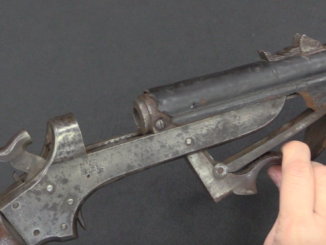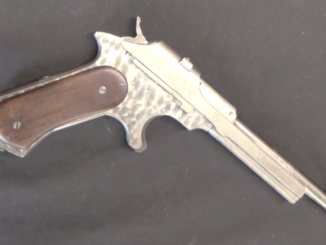Today I’m at the Cody Firearms Museum, taking a look at two of the guns that were used in the court case between Francis Bannerman and the Winchester company – a prototype Magot pump-action rifle and a Winchester-made example of a Krutzsch patent pump-action rifle.
The case came to be because Bannerman was the owner of the first US patent on a pump-action shotgun, which he acquired when Sylvester Roper went bankrupt – the patent had been originally filed by Christopher Spencer (of Spencer rifle fame). Winchester made a big splash in the market when they introduced their Model 1893 pump shotgun, and Bannerman took them to court for patent infringement in 1894.
Winchester decided to defend themselves by proving the patent was invalid, because the pump action machismo had already been invented when the patent was filed. They sent a lawyer to Europe to find some pump action design patents that would predate Spencer’s, and they came up with four! One was a very strange bullpup rifle, which I have a separate video on (https://youtu.be/HcIG5OqQjlw). Two others were by the Frenchman M.M. Magot (which Winchester purchased a prototype example of) and William Krutzsch. Failing to find an extant example of Krutzsch’s gun, the Winchester tool room built one themselves. These examples were sufficient to win the case for Winchester in 1897. They proceeded to release their improved model 1897 pump shotgun, which would prove exceptionally successful and popular.
That said, the Magot and Krutzsch guns we are looking at today are exceptionally impractical – I am not even sure how the Magot is supposed to work. But practicality is not required for a patent.
For a much more detailed account of this story, check out the multi-part article by Seth Newman at Surplussed.com.




The Roper/Spencer action was rather strong for the materials used. My Bannerman/Spencer came out of a pawn shop in the 90’s, missing the extractor – upon disassembly, I discovered the locking block had been brazed back together. I rather suspect it had been shot extensively w/ smokeless powder loads into the modern era of polymer shotgun hulls, finally breaking the locking block – which was brazed back together & likely went on shooting, only being sold out of the family when the extractor was lost. I had an aluminum extractor made for it, but only ran snap caps through it. Later picked up a legal antique Winchester 97 takedown, and it is a far better shotgun – simply b/c it doesn’t have a 2 lb steel weight flipping up & down as you cycle the action.
Hi Ian.
This isn’t related to the video, but….
I’ve just started looking at the comments generated on the website and two points strike me:
1. It’s annoying that the latest comments are at the bottom of the thread, so ya gottsta scroll down. Is it possible to have them at the top?
2. It’d be great if one could reply directly to a comment as on Patreon, rather than just post chronologically.
Ta much.
You can reply directly to a comment, like this.
And this
Duh me! Thanks.
Though it doesn’t show as ‘attached’ to your comment on my phone.
“Pump action machismo”
When your auto-correct pulls out ahead.
Pump action machismo is the most potent form
“pump action machismo”
Yes, there is a such a thing 🙂
The clung on action closing is convincing 🙂
Another number with a massive amount of contents!
Now I think about Winchester shotgun efforts with more respect than before. I also feel good for owning the M1300 slide action. Every detail on that design points to rich history behind it. I still cannot believe they lost their manufacturing capacity in the U.S. At least I was able to visit the New Haven plant before they closed.
It looks as though M. Magot may have gone on to work in machine gun development at St. Etienne some time before 1907.
These lawsuits remind me of similar lawsuits launched by the Wright Brothers to defend their patents about ailerons and other airplane components. Legal wrangling became so obnoxious that the US gov’t ordered Glenn Curtiss and the Wright Brothers to merge their companies during World War 1.
Hmmm, did not know that, thanks.
“Greg’s Airplanes and Automobiles” YouTube channel does a great video on ‘did the Wright’s actually invent the aeroplane’ or the French. Well worth a watch.
I searched for “système Mangot” in the French archives (rifle types are often preceded by the word “système” in French military writing). I found an extract of a test report in “L’indépendant” 1882 newspaper edition. The rifle was tested by the army, rate of fire is around 1/s, cardriges capacity was 23, cardriges were made of fabric to resist to the gun operation, magazine has a cut-off, no explanation on the strange thing under the bolt.